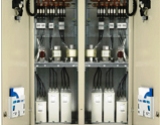Application of reactive power compensation blocks
 As soon as we are faced with the need for practical application of alternating current and in particular three-phase current, the need for compensation of reactive energy (or power) immediately arises.
As soon as we are faced with the need for practical application of alternating current and in particular three-phase current, the need for compensation of reactive energy (or power) immediately arises.
When a capacitive or inductive component of the load is included in the circuit (these can be any kind of electric motors, industrial furnaces or even power lines, common everywhere), an exchange of energy flows occurs between the source and the electrical installation.
The total power of such a flow is zero, but it causes additional losses of active voltage and energy. As a result, the transmission capacity of electrical networks decreases. It is impossible to eliminate such negative impacts, so you just need to minimize them.
Various devices based on static or synchronous elements are used for this purpose.The operation of such devices is based on the principle according to which a source of reactive power is additionally installed on a circuit section with an inductive or capacitive load. This leads to the fact that this source and the device itself exchange their energy flows only in a small area, and not over the entire network, which leads to a reduction in total losses.
The most common loads in industrial electrical networks are distribution transformers and asynchronous motors. During operation, such an inductive load serves as a source of reactive energy that oscillates across the circuit section between the load and the source. Its role does not serve to perform any useful work in the device, it is spent only on creating electromagnetic fields and acts as an additional load on the power lines.
Individual reactive power compensation is the simplest and cheapest solution. The number of capacitor banks corresponds to the number of loads. Accordingly, each capacitor bank is located directly at the corresponding load.
But this method is effective only in the case of constant loads (say, one or more asynchronous electric motors with rotating shafts at a constant speed), that is, when the reactive power of each load changes slightly over time, and to compensate, no it is necessary to change the ratings of the connected capacitor banks ... Since in individual compensation the reactive power level of the load and the corresponding reactive power of the compensators are constant, such compensation is unregulated.
